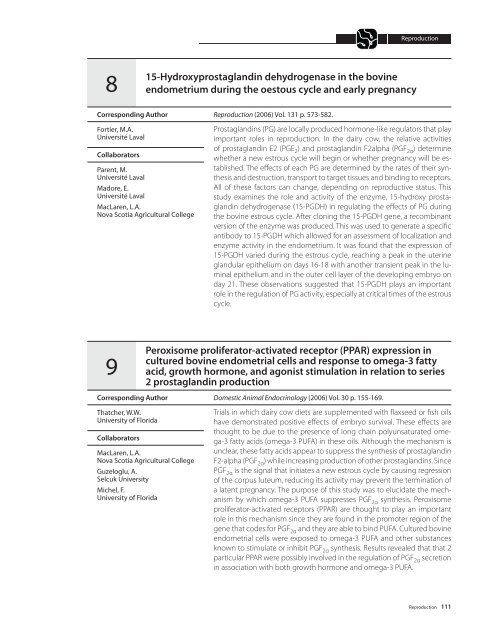A52-75-2007E.pdf - AgroMedia International Inc
A52-75-2007E.pdf - AgroMedia International Inc
A52-75-2007E.pdf - AgroMedia International Inc
You also want an ePaper? Increase the reach of your titles
YUMPU automatically turns print PDFs into web optimized ePapers that Google loves.
Reproduction815-Hydroxyprostaglandin dehydrogenase in the bovineendometrium during the oestous cycle and early pregnancyCorresponding AuthorFortier, M.A.Université LavalCollaboratorsParent, M.Université LavalMadore, E.Université LavalMacLaren, L.A.Nova Scotia Agricultural CollegeReproduction (2006) Vol. 131 p. 573-582.Prostaglandins (PG) are locally produced hormone-like regulators that playimportant roles in reproduction. In the dairy cow, the relative activitiesof prostaglandin E2 (PGE 2 ) and prostaglandin F2alpha (PGF 2α ) determinewhether a new estrous cycle will begin or whether pregnancy will be established.The effects of each PG are determined by the rates of their synthesisand destruction, transport to target tissues and binding to receptors.All of these factors can change, depending on reproductive status. Thisstudy examines the role and activity of the enzyme, 15-hydroxy prostaglandindehydrogenase (15-PGDH) in regulating the effects of PG duringthe bovine estrous cycle. After cloning the 15-PGDH gene, a recombinantversion of the enzyme was produced. This was used to generate a specificantibody to 15-PGDH which allowed for an assessment of localization andenzyme activity in the endometrium. It was found that the expression of15-PGDH varied during the estrous cycle, reaching a peak in the uterineglandular epithelium on days 16-18 with another transient peak in the luminalepithelium and in the outer cell layer of the developing embryo onday 21. These observations suggested that 15-PGDH plays an importantrole in the regulation of PG activity, especially at critical times of the estrouscycle.9Peroxisome proliferator-activated receptor (PPAR) expression incultured bovine endometrial cells and response to omega-3 fattyacid, growth hormone, and agonist stimulation in relation to series2 prostaglandin productionCorresponding AuthorThatcher, W.W.University of FloridaCollaboratorsMacLaren, L.A.Nova Scotia Agricultural CollegeGuzeloglu, A.Selcuk UniversityMichel, F.University of FloridaDomestic Animal Endocrinology (2006) Vol. 30 p. 155-169.Trials in which dairy cow diets are supplemented with flaxseed or fish oilshave demonstrated positive effects of embryo survival. These effects arethought to be due to the presence of long chain polyunsaturated omega-3fatty acids (omega-3 PUFA) in these oils. Although the mechanism isunclear, these fatty acids appear to suppress the synthesis of prostaglandinF2-alpha (PGF 2α ) while increasing production of other prostaglandins. SincePGF 2α is the signal that initiates a new estrous cycle by causing regressionof the corpus luteum, reducing its activity may prevent the termination ofa latent pregnancy. The purpose of this study was to elucidate the mechanismby which omega-3 PUFA suppresses PGF 2α synthesis. Peroxisomeproliferator-activated receptors (PPAR) are thought to play an importantrole in this mechanism since they are found in the promoter region of thegene that codes for PGF 2α and they are able to bind PUFA. Cultured bovineendometrial cells were exposed to omega-3 PUFA and other substancesknown to stimulate or inhibit PGF 2α synthesis. Results revealed that that 2particular PPAR were possibly involved in the regulation of PGF 2α secretionin association with both growth hormone and omega-3 PUFA.Reproduction 111





